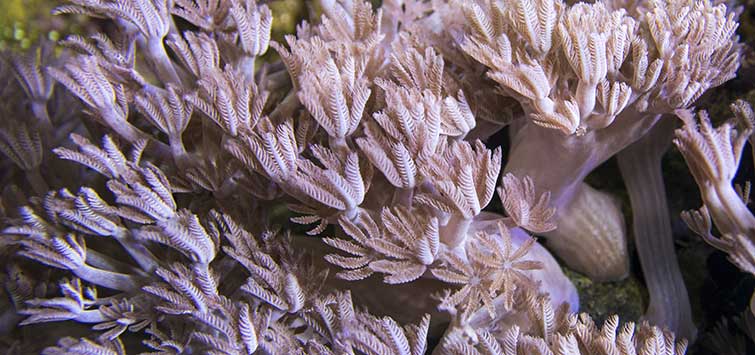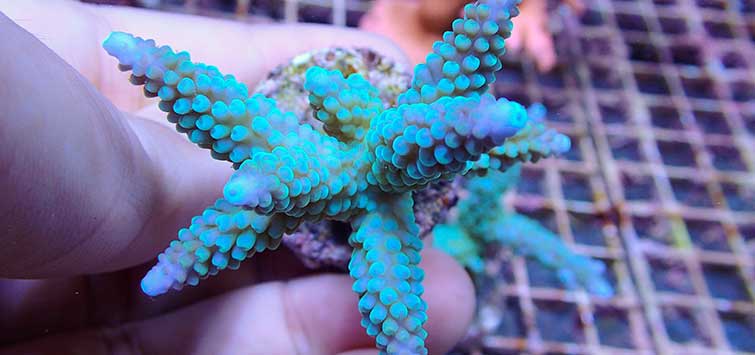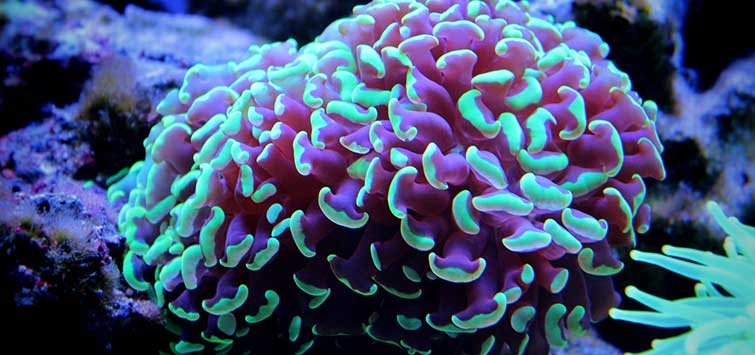The Salt Creep: Those Persnickety Pulse Corals
Author: Jeff Kurtz
This month’s “Salt Creep” topic is one near and dear to my heart—pulse corals. For many years now, my 75-gallon reef tank has been home to a thriving (usually) population of pulse corals Xenia sp., and I must confess that I derive more joy from these little beauties than from any other inhabitant of my aquarium. There’s just something about their pulsating action that I find utterly captivating
Irresistible Pulse Corals
Non-hobbyists seem to find pulse corals irresistible, as well. Visitors to my home, upon looking over the aquarium and observing the rhythmic motion of the pulse corals, typically “ooh and ahh” for a few minutes before asking questions like, “Are they actually moving on their own, or is the current doing that?” For some reason, most of them are genuinely impressed when they learn that the corals are moving all by themselves.
For those readers who are unfamiliar with pulse corals, they get their name from the pulsing—or continuous opening and closing—of the feathery tentacles of some species.
The Family Xeniidae
These corals belong to the family Xeniidae, which consists of numerous genera, including two that should be familiar to most reef keepers: Xenia and Anthelia. Members of these two genera can be easily distinguished from one another because with Xenia species the polyps arise from individual fleshy stalks, while the polyps of Anthelia species arise from a shared encrusting mat of tissue—similar to briareum (so-called encrusting gorgonians) and many zoanthid polyps. As a general rule—though there are exceptions—the truly pulsing species belong to the genus Xenia, while most Anthelia species do not exhibit pulsing behavior in the aquarium.
Does Pulsing Have a Purpose?
Many possible reasons have been offered to explain why pulse corals pulse, but the experts can’t seem to agree on a purpose for this behavior. At first blush, it would seem to have something to do with feeding. Could it be that the polyps pulse in order to trap tiny organisms or particulates in their feathery tentacles? While this explanation might seem plausible, it’s most assuredly not the case, since pulse corals are known to derive their sustenance from symbiotic zooxanthellae and the uptake of dissolved organic compounds from the water—not the capture of planktonic organisms.
Some suggest that the pulsing might help to promote water movement around the colony, which facilitates waste export. Others speculate that pulsing might be the coral’s attempt to regulate the amount of light reaching its tissues. However, no single explanation seems to satisfy this long-standing question. So, for the time being, exactly why pulse corals pulse will have to remain a mystery.
Pulsing Cessation
One aspect of pulse coral behavior that vexes many hobbyists is the tendency of these corals to inexplicably cease pulsing or dramatically slow their pulsing in the aquarium. But just as the reason for pulsing behavior is not fully understood, the reason (or reasons) behind the reduction or cessation of pulsing is a mystery, as well. The good news is that the lack of pulsing does not necessarily indicate ill health or poor husbandry. Oftentimes, the pulsing action will start up again at some future date, leaving the hobbyist scratching his or her head, at a loss for the explanation.
No Iodine Needed?
It has frequently been suggested that regular supplementation with iodine is necessary to keep pulse corals pulsing and in good health. I would humbly beg to differ, since I haven’t dosed my aquarium with iodine in almost a decade, yet my pulse corals continue to pulse and proliferate. That’s not to suggest that I’ve never witnessed a slowdown or cessation of pulsing. I have indeed seen this on numerous occasions, and in most of these cases the slowdown or shutdown of pulsing seemed to coincide with my lights exceeding their effective life span—i.e., I waited too long to replace the lamps. Once I got around to replacing them, however, the corals perked up again shortly thereafter. At other times, the pulsing seemed to stop and start up again independent of any husbandry changes on my part.
Lighting
One note when it comes to lighting and pulse corals: Purely anecdotally speaking, these corals seem to do much better under metal halide lamps (mine are currently illuminated with two 175-watt, 6500K bulbs and two normal-output actinic fluorescent tubes) than they do under strictly fluorescent illumination. I’ve kept them under both, and I’ve seen a dramatically higher rate of reproduction under metal halides.
A Need for Dissolved Nutrients
Because pulse corals take up dissolved organic compounds directly from the water, they seem to thrive under conditions that might be detrimental to sensitive stony corals. In fact, it might just be that it’s possible to keep a reef system too pristine for pulse corals to prosper.
It’s my suspicion—albeit only a suspicion—that the level of dissolved nutrients needed to sustain at least some algal growth in the aquarium might also be necessary for the maintenance of pulse corals. I say this only because some aquarists who are very aggressive about nutrient export in order to prevent algal growth report that they have limited success with pulse corals. Perhaps there’s a connection, but who knows? When it comes to keeping pulse corals, there always seem to be more questions than definitive answers.
Providing Proper Water Movement
One aspect of pulse coral husbandry that requires a little finesse is providing the right level and quality of water movement. Pulse corals are quite delicate and won’t tolerate being blasted by a powerhead pointed directly at them. Instead you’ll want to provide gentle, indirect water movement through the corals. I achieve this by intersecting the flow of a powerhead located at one end of the tank with the flow of my sump return hose located at the other end. The resulting turbulence seems to be just about right for keeping the corals in motion without overpowering them and flattening them out.
A Plague of Pulse Corals
Those who are able to provide the right set of conditions for pulse corals to thrive may soon discover that these corals are capable of prolific reproduction and can be quite invasive, spreading all around the tank and overgrowing other species to their detriment. They’ll even grow right up the glass panes of your aquarium if you let them (and I can’t help but let them!). And they can spread with astonishing speed. In just a matter of days, one colony can spread to an adjacent rock or other hard surface.
As a colony moves from one place to the next, it will typically leave behind a small glob of tissue, which will give rise to another colony in a remarkably short period. These corals can also spread to far-flung reaches of the aquarium by detaching themselves from an unfavorable location, drifting, and then settling elsewhere. Or they can drop little branches from their feathery polyps, which drift around the tank with the current, settle, and then attach on a hard substrate to form a new colony. Pulse corals also spread by releasing free-swimming larvae, called planulae, which settle and take up residence far from the parent colony.
Pulse Coral Propagation
Because pulse corals spread so easily and prolifically, they make wonderful candidates for propagation. Also, these corals, which produce copious amounts of slimy mucus when harassed, don’t tend to ship very well, so dealers are usually eager to take them off hobbyists’ hands in exchange for cash or store credit. Whenever my resident population gets out of hand, I use a razor blade to gently dislodge colonies from the aquarium glass and attach them to small rocks with rubber bands. In just a matter of days they attach themselves to the rocks, so I can remove the bands and take the specimens to my local dealer. You can also encourage the corals to attach to rocks by wrapping the rock and specimen in bridal veil, or by simply placing the dislodged specimen in a tray or bowl filled with rubble.
When banding pulse corals to rocks, make sure the band isn’t so loose that the specimen can drift away after shrinking just a bit, or so tight that it bifurcates and slips out of the bands. Also, be as gentle as you can when handling pulse corals. As I’ve mentioned, pulse corals can be pretty slimy, and rough handling usually yields a gooey, unmanageable mess. I typically do all of my banding work under water, gently nudging a loose specimen onto into position on the rock and then applying the bands.
The Dreaded Pulse Coral “Crash”
Most aquarists who keep pulse corals will, at one time or another, experience a population “crash.” Usually when a crash occurs everything seems to be going along just fine when suddenly—and seemingly out of a clear blue sky—most or all of a colony goes into “meltdown” and dies off. I had such an experience about six years ago just before I switched my aquarium lighting from power compacts to metal halides. Without warning, my pulse corals stopped pulsing and began to disintegrate right before my eyes. A strong squirt of water from a turkey baster would cause a crashing specimen to literally come apart. Needless to say, I was beside myself over this turn of events.
Diagnosing the Problem
When a crash occurs it’s natural for the aquarist to wonder what went wrong and to re-examine every aspect of aquarium maintenance to determine where the “breakdown” took place. But more often than not, the crash has nothing to do with the aquarist’s skill. So why does this happen? As with so many aspects of pulse-coral keeping, exactly why crashes occur is not fully understood. It could be that some vital (and yet-to-be-identified) dissolved nutrient is used up and no longer available to the colony. Or, perhaps, pulse corals are just naturally short lived. Whatever the cause, the key for the aquarist who is grappling with this underwater Armageddon is to avoid succumbing to panic because all is not necessarily lost.
Maintenance
As the crash progresses, perform frequent water changes, taking care to siphon out any dead tissue to prevent your biofilter from being overtaxed. You’ll probably notice that small amounts of healthy-looking tissue are left behind on some surfaces after the crash. These will very likely develop into new colonies after the situation stabilizes. Just be patient and keep up with your regular maintenance chores, correcting any parameters that are out of line, and your pulse coral population may very well rebound.
In my case, the crash quickly subsided, and before I knew it I had more pulse corals than I knew what to do with. And that’s a fix I don’t mind finding myself in!

.png?h=595&iar=0&w=2781&hash=5FD5E69473BCC22199FBFA2FB71B6033)



